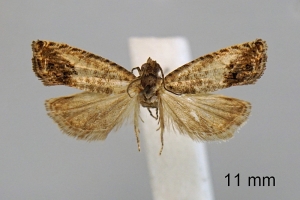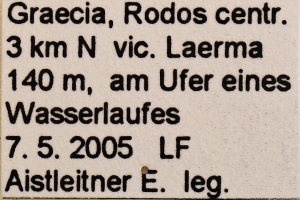2. Diagnose
2.1. Männchen
3. Biologie
3.1. Nahrung der Raupe
- [Fabaceae:] Anagyris foetida (Stinkstrauch)
Die Raupennahrung galt zunächst als unbekannt. Valipour et al. (2015) meldeten dann aber aus dem Iran: "Stinking bean trefoil, Anagyris foetida L. (Leguminosae) is a typical shrub species in the forests of Gilanegharbe city, in Kermanshah province. The larvae of Cydia johanssoni Aarvik and Karsholt (Lep. : Tortricidae) are the most important pest on A. foetida and would damage the seeds by feeding them." Sie beschrieben die Larvenstadien und ihre Lebensweise und zeigten auch Bilder dazu. A. foetida ist im Mittelmeerraum verbreitet, kommt also auch auf Kos und in Bari vor.
4. Weitere Informationen
4.1. Faunistik
Locus typicus: Griechenland, Kos, Asfedion.
Trematerra & al. (1997: 185) und Trematerra, P. & L. Aarvik (1998) berichten über einen Fund in Italien, konkret "Puglia: Polignano (Bari), 10-15 m, 20-VI-1977." Der Fund führte dann auch zur Neuaufnahme in das "Update to the “Catalogue of Lepidoptera Tortricidae of the Italian Fauna” (2003-2020)" von Trematerra (2020: 48).
Aus dem Iran meldeten Valipour et al. (2015): "Stinking bean trefoil, Anagyris foetida L. (Leguminosae) is a typical shrub species in the forests of Gilanegharbe city, in Kermanshah province. The larvae of Cydia johanssoni Aarvik and Karsholt (Lep. : Tortricidae) are the most important pest on A. foetida and would damage the seeds by feeding them."
Morin & Nel (2022) überraschten mit der Neubeschreibung von Cydia murgiai von Sardinien - dabei nahmen sie den Vergleich mit der Genitalzeichnung von C. johanssoni von Razowski (2003) und mit den Angaben von Valipour et al. (2015) vor, nicht aber mit dem Tier von Bari. Hier besteht also noch Klärungsbedarf.
(Autor: Erwin Rennwald)
4.2. Literatur
- Erstbeschreibung: Aarvik, L. & O. Karsholt (1993): New and little known Grapholitini (Lepidoptera, Tortricidae) from the Mediterranean area. — Nota lepidopterologica 15 (3/4): 164-178. [Digitalisat auf www.archive.org]
- Morin, L. & J. Nel (2022): Descrizione di Cydia murgiai sp.n. scoperta in Sardegna (Italia) / Description de Cydia murgiai sp.n. découverte en Sardeigne (Italie) (Lepidoptera, Tortricidae, Olethreutinae). — Revue de l'Association Roussillonnaise d'Entomologie, 31 (1): 56-60.
- Trematerra, P. (2020): Update to the “Catalogue of Lepidoptera Tortricidae of the Italian Fauna” (2003-2020). — Journal of Entomological and Acarological Research 52: 45-49. [PDF auf pagepressjournals.org]
- Trematerra, P., Sciarretta, A. & P. Parenzan (1997): Note faunistiche su alcuni interessanti Tortricidi dell'Italia meridionale (Lepidoptera). — Entomologica 31: 181-189. Bari. [PDF auf ojs.cimedoc.uniba.it]
- Trematerra, P. & L. Aarvik (1998): Record Cydia johanssoni Aarvik and Karsholt, 1993 new for the Italian fauna with description of the female. — Bollettino di Zoologia Agraria e di Bachicoltura, 30 (1): 33-38. [Sekundärzitat]
- Valipour, J., Vahedi, H.A. & A.A. Zamani (2015): Preliminary morphological study of developmental stages of Cydia johanssoni Aarvik & Karsholt (Lep: Tortricidae) on stinking bean trefoil, Anagyris foetida L. (Leguminosae) in Iran. — Journal of Applied Environmental and Biological Sciences, 5(7): 299-304. [PDF auf textroad.com]




![Vorkommen in Italien (Festland und kleine festlandsnahe Inseln) [Trematerra (2020): Update to the “Catalogue of Lepidoptera Tortricidae of the Italian Fauna”]](/res/img/flag/it.gif)
![Vorkommen auf den Dodekanesischen Inseln (Griechenland) [die Art wurde von der Insel Kos beschrieben. Foto im Forum]](/res/img/flag/gr.gif)
![Vorkommen in Iran [siehe Faunistik]](/res/img/flag/ir.gif)



